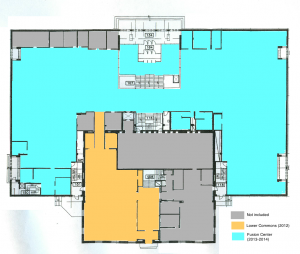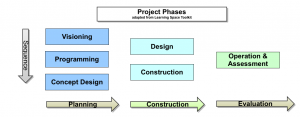Fusion Center
Watch this space.
This page will become the project page for the next phase of Library renovation: the Fusion Center. While “the Fusion Center” is the working name for the space, you may also see it referred to as the “Learning Commons” or “upper commons”).
FUSION: a merging of diverse, distinct, or separate elements into a unified whole.
http://www.merriam-webster.com/dictionary/fusion
The Lower Commons / After Hours project focused on creating a high quality social learning and study space for Drake students. The next phase of the project focuses on more structured learning spaces (classroom, presentation practice, media creation, group studies) and creating a service rich environment by providing access to a variety of academic support services (the Library, Writer’s Workshop and more.)
What is a Learning Commons?
A learning commons is an evolving model for delivery of academic and instructional support services to a specific population of students and faculty. Originating in higher education, the commons concept has proven so successful that it is spreading to business, secondary schools, and even into primary schools.
In it’s earliest iterations the commons focused on integrating a variety of student services within in a common environment, generally the university library. As time has gone on, the commons has grown beyond simple collaborative service delivery to focus on creating and sustaining high-quality, functional and dynamic learning environments. While students remain the focus of most learning commons instances, a few — such as the Weigle Information Commons at the University of Pennsylvania — also focus on providing instructional support services to faculty, particularly as they relate to integrating new technologies into instruction.
Traveling under a variety of names — learning commons, knowledge commons, academic commons — the learning commons is a primarily social and collaborative space, technology-rich and service-focused.
Although the commons is often library-centered, it is not necessarily “library-centric.” Libraries are a significant component of nearly all learning commons, given their key role in the provision and use of knowledge resources and established service emphasis.
From the library’s standpoint, the commons allows the library to perform traditional functions related to research, reference, knowledge management and information literacy within a larger, collaborative service environment. This larger environment facilitates academic success, the utilization of knowledge in new media formats and instructional effectiveness. Other academic service units find space within the library — popular, central, and desirable — to significantly impact their outreach to students and faculty.
Sources:
D. Russell Bailey. “From Information Commons to Learning Commons” ACRL National Conference. Minneapolis, MN. Apr. 2005.
Available at: http://works.bepress.com/d_r_bailey/28
Beagle, Donald. “From Learning Commons to Learning Outcomes: Assessing Collaborative Services and Spaces.” (Research Bulletin). Boulder, CO: EDUCAUSE Center for Applied Research, September 27,2011, available from http://www.educause.edu/ecar
Frequently Mentioned Models for a Learning Commons
We believe that each of the models listed below offer approaches and insights of value in developing a commons that is uniquely suited to Drake University. Comments about a particular commons are based on the institution’s web site, articles in the professional literature and various other sources and should not be taken as authoritative.
University of Massachusetts – Amherst Learning Commons
One the earliest and “classic” implementations of the Learning Commons concept, the emphasis here is on combining many academic support services (including field internships and study abroad) in a space directly shaped and conceived as putting technology first.
http://www.library.umass.edu/learningcommons/
David B. Weigle Information Commons, University of Pennsylvania
Under the leadership of Dr. Anu Vendantham, the Weigle Commons focuses on interactions with both faculty and students. An emphasis on new media and using new technological components in instruction is evident. The triple focus on faculty, students, and technology makes the Weigle Commons an attractive model.
http://wic.library.upenn.edu/
The University of British Columbia Learning Commons
One of the newer Commons, UBC makes extensive use of peer-based interactions (peer coaches), tutoring and other student based workshops in providing academic support services.
http://learningcommons.ubc.ca/about-us/chapman-learning-commons/
Noel Studio for Academic Creativity, Eastern Kentucky University
Not conceived strictly as a commons, the Noel Studio is focused on the uses of knowledge in creative output. Highly conscious about the uses of space, this model incorporates considerable peer interaction and includes a “Discovery Classroom” for innovative teaching experimentation.
http://www.studio.eku.edu/
North Carolina State University
The epitome of large scale — everything is done on a massive level. Another early commons model, the focus on student use of the space is outstanding. An innovative commons with a strong emphasis on assessment, NCSU continues to innovate with SCALE-UP, learningspacetoolkit.org, and more.
http://www.lib.ncsu.edu/learningcommons
http://scaleup.ncsu.edu/
http://learningspacetoolkit.org
Daniel M. Soref Learning Commons, University of Wisconsin, Milwaukee
The Soref Commons is a somewhat more library-centric commons focusing on library services and resources, technology, and using some student groups to provide services, academic assistance, and socialization. The library focus leads to a space that makes extensive use of group study facilities.
http://www4.uwm.edu/libraries/commons/
Development Process
Scope of the Project

Continuing the renovation that began with the Lower Commons / After Hours project in 2012, the next phase of renovation embraces much of the main floor.
Phases of Development

Our project will move through three broad phases: planning, construction and evaluation (assessment). We are current in the visioning portion of the planning phase.

The Planning Phase focuses on vision, program and concept design. The outcomes are design documents used by the architect to create the actual renovation plans.

Planning Phase: Vision Stage: Activities – Preliminary list of Initiative Group activities, 9-12-2012
Organization
Library Initiative Group
This group is the “steering committee” for the process. It will establish the framework and direct the course of the planning process. Membership: Rod Henshaw, Library Dean; Claudia Frazer, Digital Initiatives Coordinator and Associate Professor of Librarianship; Dr. Susan Fink, Coordinator – Administrative Services and University Lecturer; and, Marc Davis, Special Projects Coordinator.
Documents
* From Educause/ELI: Things You Should Know About The Modern Learning Commons [PDF]


